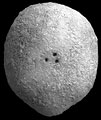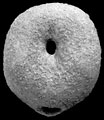Philip (1963, p. 719) describes the periproct in Notolampas flosculus as submarginal, overhung by the posterior interambulacrum. The periproct is later described by Holmes (1995) as varying from submarginal to supramarginal, but in both cases the periproct is obscured by a projecting lip in interambulacrum 5. Such variability of these features precludes recognition of two distinct subspecies (Holmes, 1995).
Philip (1963, p. 719) also reports that Notolampas has prominent bourrelets and wide phyllodes, with pores arranged in four irregular series in each. The bourrelets are inflated, however, the phyllodes are not distinctly widened and the pores do not form four irregular series in each phyllode. The phyllodes have an outer series of expanded pores, plus a few occluded pores in between. Philip (1963) would appear to have mistaken the spheridial pits for pores in the ambulacra.
Notolampas is very similar to Neolampas both genera having a very similar periproct, a monobasal apical system with only three gonopores (no gonopore in genital plate 3), a longitudinally ovate peristome, with similar floscelle development. The bourrelets appear to be slightly more inflated in Notolampas, while the adoral surface is centrally more depressed in Neolampas. Such characters are not worthy of generic distinction, therefore Notolampas should be considered a subjective junior synonym of Neolampas A. Agassiz, 1869.
F. C. Holmes. 1995. Australian Tertiary Neolampadidae (Echinoidea): A review and description of two new species. Proceedings of the Royal Society of Victoria, 107 (2), pp. 113-128.
G. M. Philip. 1963. Two Australian Tertiary neolampadids, and the classification of cassiduloid echinoids. Palaeontology 6 (4), pp. 718-726.




